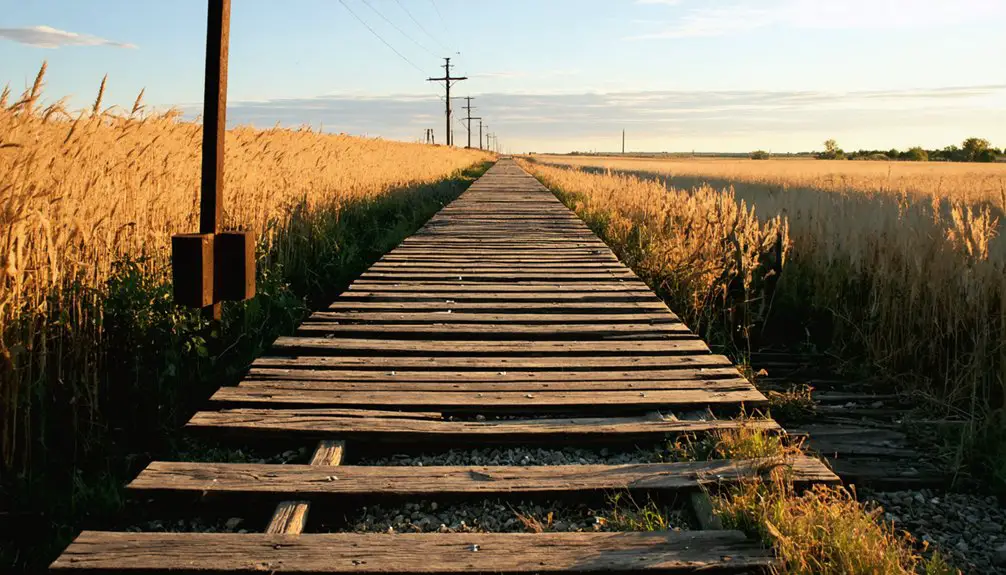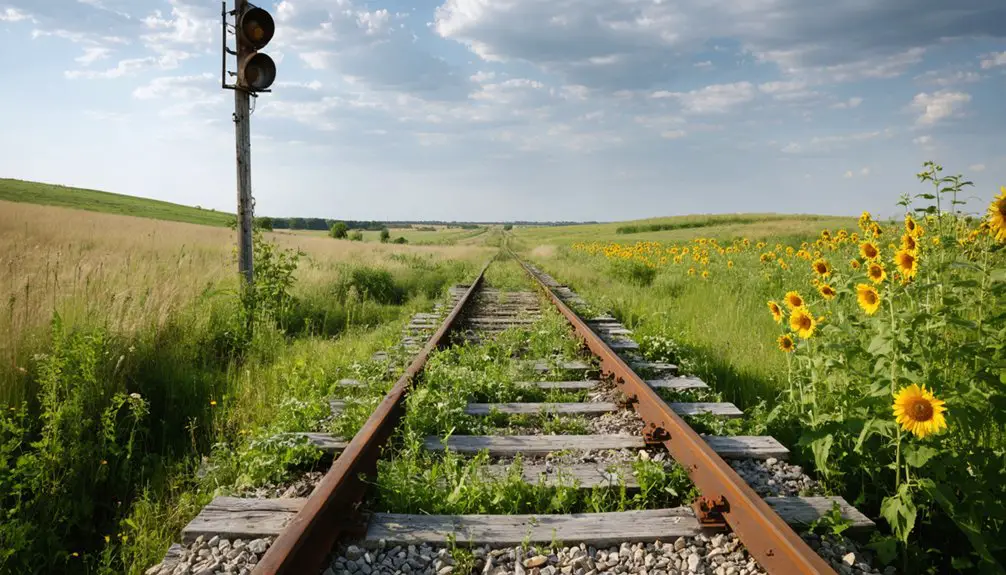You’ll find Guittard Station 3.5 miles north of Beattie in Marshall County, Kansas, where George Guittard built a frontier outpost in 1857. His 12-room lodge became a premier stop along the St. Joseph to Fort Kearny route, serving both Pony Express riders and stagecoach travelers. While most original structures have vanished, a 1931 stone marker with a bronze plaque marks this historic site. The station’s rich legacy holds countless stories of frontier life and famous visitors.
Key Takeaways
- Guittard Station was established in 1857 as a frontier outpost in northeast Marshall County, Kansas, beginning with a tent and log cabin.
- The station featured a prominent 12-room lodge built in 1859 that served Pony Express riders and stagecoach travelers along westward routes.
- Original structures have largely disappeared, though a 1931 stone marker with bronze plaque marks the historical site’s location.
- Some lumber from the 1859 lodge was salvaged and repurposed into a new dwelling in 1910, with one original door surviving.
- The ghost town site sits along Vermillion Creek, 3.5 miles north of Beattie, marked by distinctive red sandstone and granite boulders.
Early Settlement and Station Origins
When George Guittard arrived in northeast Marshall County in 1857, he established what would become one of Kansas Territory’s most significant frontier outposts. A former French magistrate, he led his family west via rail, river steamer, and ox team, facing the pioneering challenges of frontier life along Vermillion Creek.
You’ll find their first shelter was modest – a tent followed by a log cabin on the creek’s left bank. In 1859, he constructed a twelve-room lodge to accommodate the growing number of travelers passing through the region. Like Marshall County pioneer Frank Thomann and his family who arrived that same year, early settlers faced numerous hardships establishing their homesteads.
The location proved strategic, positioned along major westward routes from St. Joseph to Fort Kearny. While Native American presence created occasional tension in the community dynamics, the area offered abundant game and essential resources.
Life at a Frontier Rest Stop
As travelers approached Guittard Station in the late 1850s, they’d find a bustling 12-room lodge that served as an essential rest stop along the rugged Kansas frontier.
Inside, you’d witness the daily routines of station staff preparing fresh horses, maintaining two fully-stocked stables, and keeping the blacksmith shop ready for wagon repairs.
Your traveler interactions would center around the large waiting room, where you could rest while staff tended to your horses and replenished your provisions.
Xavier Guittard oversaw these round-the-clock operations, coordinating with Pony Express riders and stagecoach passengers alike.
At the creek’s edge, you’d find welcome shade and water, a revitalizing respite from the rolling prairie. Today, Margaret Polson continues the station’s welcoming tradition by greeting hikers who pass through.
The station’s skilled laborers worked tirelessly, ensuring every visitor could continue their westward journey safely and promptly.
The distinctive landscape featured a creek bed with red sandstone bottom and large granite boulders scattered throughout.
Notable Travelers and Historical Accounts
During your journey back to 1860, you’d find English explorer Richard F. Burton at Guittard Station, meticulously documenting the rapid changeovers of Pony Express riders as they charged through Kansas Territory.
Your path might cross with famous frontiersmen like Jim Bridger and Buffalo Bill Cody, who counted among the station’s notable visitors during its heyday as a premier rest stop.
You’d likely share Ben Holladay’s assessment that Guittard’s accommodations stood as the finest stage station between Missouri and the Rockies, offering weary travelers a welcome respite from the rugged prairie trail.
The 12-room lodge provided essential amenities for the increasing flow of westward travelers seeking new opportunities in the expanding American frontier.
George Guittard, who settled in Marshall County in 1857, established this important waypoint and helped organize the county’s development.
Burton’s Historical Visit Description
Richard Burton’s 1860 visit to Guittard Station provides one of the most detailed contemporary accounts of this frontier outpost. His observations captured the station during its prime as an essential Pony Express relay and Overland stage stop.
You’ll find his description particularly valuable for understanding frontier life just before the Civil War, as he documented everything from the station’s physical layout to its daily operations.
- A large two-story house stood beyond a shady creek with a distinctive red sandstone bottom.
- Two stables housed over 20 saddled horses, ready for fresh Pony Express mounts.
- The kitchen served notable frontier luxuries, including ham, eggs, hot rolls, and even peaches with cream.
Compared to other stations where travelers endured basic and spartan meals, Guittard’s offered remarkably better dining conditions.
Burton’s historical significance lies in his thorough documentation of this strategic hub along the Fort Leavenworth to Fort Kearny Military Road.
Passing Pony Express Riders
The bustling Pony Express operation at Guittard Station brought remarkable riders through its gates during the service’s brief 19-month existence.
You’d have witnessed Jack Keetley, who rode throughout the entire Pony Express era, thundering through on his legendary 340-mile trek completed in just 31 hours. Alex Carlyle, the first rider out of St. Joseph, passed through until health issues forced his retirement, while Gus Cliff and John Frye followed in his hoofprints along the Overland route.
These riders’ experiences at Guittard were marked by lightning-fast horse changes near the shaded Vermillion Creek, where they’d grab food and water while blacksmiths guaranteed their equipment was trail-ready. Each rider faithfully adhered to the NPEA sacred oath, strictly avoiding profanity and intoxicating liquors during their service. The riders carried letters at five dollars per ounce when the service first began operations.
The station’s two-story lodge offered brief sanctuary before they’d race westward, carrying mail across the untamed frontier.
Stagecoach Passenger Experiences
While stagecoaches rumbled through Guittard Station daily, English traveler Richard F. Burton witnessed the bustling activity firsthand in 1860, describing it as a “clump of board houses” near the wooded Vermillion Creek.
Your travel experiences at this crucial stop would’ve included essential services at the impressive 12-room lodge. The station earned a reputation for providing clean facilities and food to weary travelers.
During your journey between Missouri and California, you’d have encountered:
- A welcoming waiting room offering respite from the dusty trail
- Fresh horses from the 20-stall barn, where blacksmiths guaranteed coaches kept rolling
- Critical passenger interactions with station staff, including Xavier Guittard, who managed daily operations
Ben Holladay himself trusted George Guittard with key business affairs, highlighting the station’s significance on the Fort Leavenworth to Fort Kearny Military Road route.
The Station’s Role in Transportation History

You’ll find that Guittard Station served as a critical transportation hub, operating both as a Pony Express relay point with two stables housing over 20 horses and as a primary stop on the Overland Stage line between Fort Leavenworth and Fort Kearny.
The station’s 12-room lodge and blacksmith shop provided essential services to travelers, including lodging, repairs, and fresh horses for the demanding mail delivery schedule.
The facility’s strategic location along Vermillion Creek made it an indispensable waypoint for settlers, military personnel, and legendary figures like Buffalo Bill who traversed the St. Joe Road toward the Great Platte River Road.
Key Stagecoach Stop Operations
During the height of westward expansion, Guittard Station emerged as an important transportation hub along the Fort Leavenworth to Fort Kearny Military Road, serving Russell, Majors, and Waddell’s Overland Stage Line.
You’d find thorough stagecoach logistics and traveler accommodations at this essential waypoint, where the Guittard family managed operations from their impressive 12-room lodge built in 1859.
At this bustling station, you’d experience:
- Swift horse relays from two well-maintained stables housing over 20 fresh horses
- Important blacksmith services for wagon and coach repairs in the dedicated shop
- Comfortable respite in the station house’s waiting room while crews managed your transportation needs
The station’s strategic location near Vermillion Creek provided critical water access and shelter, making it indispensable for your westward journey.
Pony Express Relay Point
Beyond its role as a stagecoach hub, Guittard Station became an essential Pony Express relay point in 1860, connecting Missouri to California through an innovative mail delivery system.
You’ll find evidence of the station’s significance in its impressive infrastructure, which included two well-equipped stables housing over 20 horses for quick mount changes during mail dispatch runs.
English traveler Richard F. Burton witnessed this operation firsthand when he observed a Pony Express rider arriving at the station in late 1860.
The station’s strategic location near Vermillion Creek made it crucial for the legendary mail service, which operated until October 1861.
While the original buildings no longer stand, a stone marker erected in 1931 by the Oregon Trail Memorial Association commemorates this essential piece of American transportation history.
Blacksmith Services And Repairs
The blacksmith shop at Guittard Station formed the backbone of its transportation support services, operating from a specially designed section of the stone stable that housed 20-24 horses.
You’ll find this wasn’t just any frontier repair stop – it was a critical hub where blacksmith techniques kept the wheels of westward expansion turning, literally and figuratively.
If you’d visited the station during its heyday, you’d have witnessed:
- Skilled smiths hammering out horseshoes and repairing metal fixtures
- Wagon repairs being performed on everything from simple axles to complete rebuilds
- Stage coaches getting quick-turn maintenance to keep mail and passengers moving west
The station’s strategic location on the Fort Leavenworth to Fort Kearny road made it indispensable for travelers, ensuring their journey wouldn’t be derailed by equipment failures.
Geographic Features and Local Landscape

Situated along the winding Vermillion Creek in Marshall County, Kansas, Guittard Station occupied a strategic position approximately 3.5 miles north of present-day Beattie.
The landscape ecology surrounding the station featured a perfect blend of rolling prairie and dense woodland, creating an ideal environment for both travelers and livestock. You’ll find the site nestled among gently undulating hills, where the creek’s red sandstone bottom and scattered granite boulders add distinct character to the terrain.
Majestic rolling prairies meet dense woodlands, while red sandstone and granite outcrops paint nature’s masterpiece across the undulating terrain.
The station’s location maximized available water resources, with Vermillion Creek providing essential sustenance for horses and travelers alike.
The well-wooded creek banks offered natural shelter, while the open grasslands supplied ample grazing space. This diverse landscape supported the station’s extensive infrastructure, including its two-story house, 24-stall barn, and blacksmith shop.
Legacy and Historical Preservation
While most original structures have vanished from Guittard Station‘s landscape, a 1931 stone marker with its bronze plaque stands as the primary physical evidence to this historic site. The plaque’s enduring message, “1860-61 Guittard Station—East 80 Rods Oregon Trail,” preserves the historical significance of this once-bustling transportation hub.
Key elements that shaped preservation techniques include:
- The repurposing of original lumber from the 1859 lodge into a new dwelling in 1910
- A surviving door in the second story of the rebuilt structure
- The Oregon Trail Memorial Association’s commitment to marking the site’s location
You’ll find that despite its ghost town status, Guittard Station’s legacy lives on through historical literature, heritage tourism, and its role in early regional development along the Pony Express route.
Frequently Asked Questions
What Crops Did the Guittard Family Grow to Sustain the Station?
Envision this frontier feast: You’d find they’re growing vegetables in curved gardens, oats reaching 600 bushels, millet straw, prairie hay, peaches, plus corn cultivation and wheat production sustains their pioneering spirit.
How Much Did Travelers Pay for Lodging at Guittard Station?
You’d likely have paid between $1-3 per night for lodging at the station, though exact prices aren’t documented. These rates aligned with typical frontier traveler experiences at comparable stagecoach stops.
Were There Any Native American Encounters Reported at the Station?
You won’t find documented Native encounters at this station in historical records. While travelers passed through indigenous territories, there’s no evidence of significant historical interactions at this specific location.
What Happened to the Guittard Family After the Station Closed?
You’ll find the Guittard legacy became more focused on ranching and agriculture after 1910. Like many pioneer families, their dispersal isn’t well documented, though they maintained local roots through their rebuilt homestead.
Did Any Outlaws or Criminal Activities Occur at Guittard Station?
You won’t find any outlaw legends or criminal history tied directly to this station. Historical records and primary sources don’t document any bandit activity or crimes at this location.
References
- https://nimblewillnomad.com/odyssey-2016-journals/
- https://legendsofkansas.com/guittard-station-kansas/
- https://www.legendsofamerica.com/pony-express-division-one/
- https://www.youtube.com/watch?v=alC1wDdSVvg
- https://www.hmdb.org/m.asp?m=77972
- https://history.nebraska.gov/wp-content/uploads/2017/12/doc_publications_NH1985Guittard.pdf
- http://www.ksgenweb.org/archives/1912/t3/thomann_frank.html
- https://bscottholmes.com/content/guittard-station-pony-express
- https://www.nps.gov/poex/learn/historyculture/upload/Saddle-Up-at-Guittard-508-2.pdf
- https://www.nps.gov/poex/learn/historyculture/guittard-station-exhibits.htm



